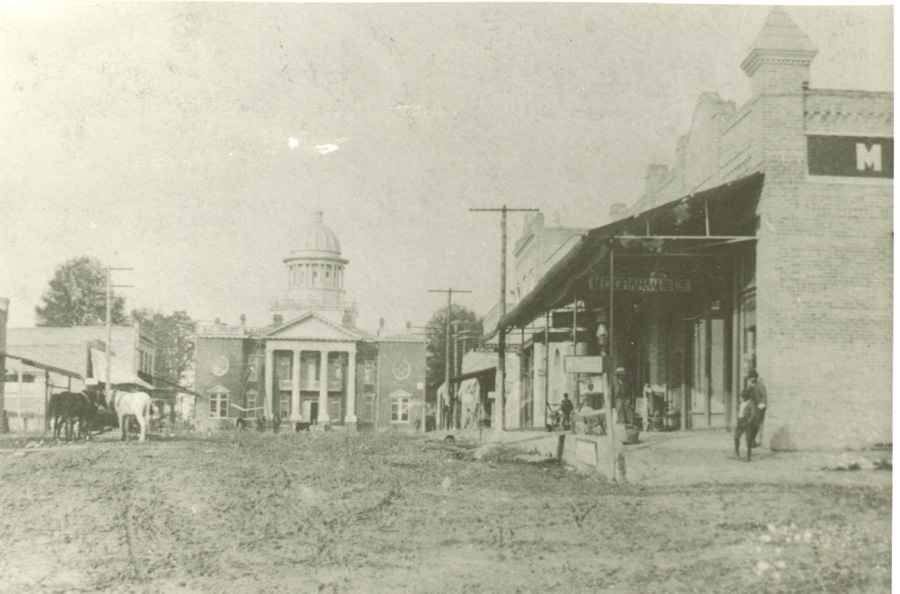
Scott County Courthouse
in the 1920s
History of Scott County
Information gleaned from
Official Website of
Forest, Mississippi
The territory which now constitutes Scott County was granted to the State of Mississippi and to the United States at the treaty of Dancing Rabbit Creek, concluded on September 27, 1830. The counties included in the Choctaw Purchase were Noxubee, Neshoba, Leake, Newton, Smith, Jasper, Clarke, Lauderdale, and Scott, all located in the central part of the state and six counties in other areas.
The Treaty of Dancing Rabbit Creek stipulated that the Choctaw Indians leave the area of the Choctaw Purchase as quickly as they safely could. The number of Choctaws who emigrated to the Choctaw Nation west of the Mississippi River was reported by the Commissioner of Indian Affairs of 1838 to have been 15,177.
Scott County, which was named for Governor Abram M. Scott, was formed on December 23, 1833. Governor Scott, a native of South Carolina, lived in Wilkinson County, Mississippi and served two terms as Lieutenant Governor.
The members of the first Scott County Board of Police (now called the Board of Supervisors) were John Dunn, James Russell, Wade H. Holland, Stephen H. Bery, and Jeremiah B. White. Other Officials were Sheriff John Smith, Clerk of the Probate Court Nicholas Finley, and Probate Judge William Ricks.
Scott County contains 584 square miles or 373,760 acres. It is one of the so-called "Hill Counties", not because it is extremely hilly, but to distinguish it from the Delta counties. It is a part of the Jackson Prairie Belt, consisting mostly of rolling upland prairie soil. Farming was the principal occupation of the early settlers of Scott County. Cotton was by far the most prevalent crop, but the early settlers, grew row crops for food.
According to the first census taken after the organization of the county, there were only about 200 white families with an average of two slaves per family. During the next ten years the population almost tripled. Many settlers in the Scott County area came from, or were descendants of people who came from France, Ireland, England, Germany, and Scotland. The first white child born in Scott County, A. B. Smith, was born in Hillsboro but moved to Forest in 1869. He was both a lawyer and leading Democrat of the time.
Scott County was never thickly populated with Indians, but there were several Indian towns in the county, the most important being Piketon, located about 12 miles northeast of Forest. The Indians easily made friends with the new settlers and Big Fat Sam, an Indian Chief, acted as interpreter. The Indians furnished the Simmons and Pevey Hotel with squirrel, deer, and other types of fresh meat from the area.
The Mississippi-Alabama Railroad mapped an east-west route through the state in 1855 and a site was selected through south central Scott County. The completion of the railroad in 1858 was the first step toward building Forest as the trade center of the county. Railroad contractors in Scott County were E. Gresham, James P. Clark, and Warren Clark. The railroad was built almost entirely with slave labor. On September 20, 1860 the first train reached Newton, Mississippi, just east of Forest. Railroad officials, headed by Mr. Vossburg, gave the crowd gathered in Newton a Ride to Forest and Back on the Train. The railroad was first called the Southern Railroad, then the Vicksburg and Meridian line, and later the Alabama and Vicksburg railroad.
In connection with the railroad there were soon telegraph lines, the Western Union, which ran parallel to the railroad, and the postal telegraph.
People who came to the central Mississippi area in the Mid-1800's found a land of towering pines so thick that the sunlight could barely penetrate to the ground, which was thickly covered with pine needles.
A ridge which rises in the Chunky River Swamp passes through the Forest and Scott County area before disappearing into the Pearl River near Jackson. Because of this ridge some of the local streams flow northward.
Settlers arriving in this beautiful forested area soon began to congregate in the area of the railroad. Forest was incorporated as town in 1860 and was being settled rapidly when the Civil War began. During the war Forest was almost a deserted village. Mr. George Brown began construction on the first House in Forest, but before it was finished, several other homes were started and completed. Although Mr. Brown's house was only partially completed, he provided food and lodging to travelers and also cared for their livestock. Captain David M. Womack, a prosperous merchant, and Make D. Graham and their families arrived soon after Mr. Brown.
Before completion of Mr. Brown's house, John C. Simmons and C. W. Pevey began construction of a hotel, the first building to be completed. In a small frame building in the yard of the Simmons and Pevey Hotel, the first printing press in Forest was operated by James P. Dement, aided by Pat Henry. The first livery stable was owned by Mr. Pevey. The hotel and livery stable were destroyed by fire several times but were rebuilt. Mr. Pevey, along with a Mr. Hood, later operated a department store on the main street of the town. Captain Simmons was the grandfather of Mr. George Antley, a long-time Forest businessman who specialized in real estate.
The first merchant to establish a business in Forest was Mr. Briscoe. Other businessmen of the time were Lod Moore, who owned a mercantile store; W.W. Lowry, T. M. Steele, who owned a department store, Make D. Graham, Morgan Colbert, Ben Wolf, G.C. Rew, G.H. Banks, and J.F. Story.
A man named Mr. Eastland operated the first drug store, and Tom Mitchell owned a jewelry store. Dr. Hillard Gardner was a merchant who was also considered one of the best doctors of his time. The first post office was located in his store. In 1873, Henry Garett opened a blacksmith shop.
Other early settlers in the Forest area included the Harpers, Smiths, Hogans, Manns, Clark, Carols, Lacks, Singletons, Womacks, Hoods, Hendons, Granvilles, Millens, and Mitchells. Wade Needham and Anderson Jennings operated what was probably the first black business in the town of Forest, an African-American barbershop. Older black families of the Forest area were Burke, Hood, Lamb, Lovelady, Battle, Moore, Body, McLaurin and Garett. Allen Lightfoot was an herb doctor who collected native plants for medical purposes. Miss. Nettie Lovelady, a midwife, was much sought after by the people of the Forest area.
Berryville, which no longer exists as a town, was the first seat of county government. It was located four miles southwest of the city of Forest and served as the county seat. Since 1866 Forest has been the center of county government.
Prior to the Civil War, the county seat of Scott County was located at Hillsboro. During the Civil War it was burned to the ground during Sherman's Meridian Campaign. On November 8, 1865, a motion was made in the legislature to relocate the county seat. The election was held, and Forest was selected by a large majority. This caused one of the largest controversies in county history.
People from Hillsboro stormed the new courthouse and set fire to the roof in hopes of totally destroying the new establishment. Their plot was foiled and only a small part of the courthouse was burned. People from Forest spent the rest of the night entrenched around the courthouse with guns, determined that no harm would come to their much desired courthouse.
The result of the first elections were then suspended, and in the next election, Forest lost decisively. The intracounty turmoil was so great that it approached a small-scale war. Forest was dissatisfied and demanded another election. In the first week of May, 1873. The third and last election was held, Forest won by a large margin.
The city of Forest has had four courthouses. The first was a frame building and the second and third were built of brick. During the time the third courthouse was in use, people often gathered on Saturdays to listen to preachers or other speakers. Because of a faulty foundation, this third courthouse was replaced by the building which is in use today. All of the early courthouses had a watering trough for animals on the east side. An intensive renovation of the latest courthouse was begun in 1996.
History of North Scott County
Additional History
More History
Last Update
Friday, 09-Mar-2018 02:40:37 CST
MSGenWeb State Coordinator
|
 |
MSGenWeb State Coordinator:
Jeff
Kemp
MSGenWeb Asst. State Coordinator:
Denise Wells
Gayle Triller, Scott County Coordinator
Copyright © 1996-Present by the MSGenWeb Team. All
rights
reserved. Copyright of submitted items
belongs to those responsible for
their authorship or
creation unless otherwise assigned.
Some of the photographs on this page are courtesy of the
Library of Congress, Prints and Photographs Division |
 |
|

